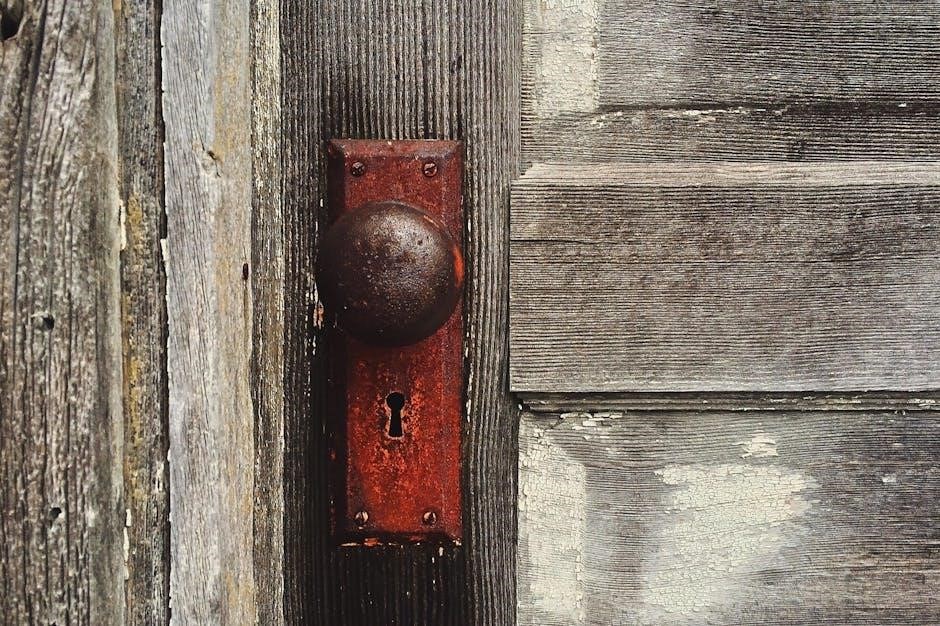A bead size chart is a guide for jewelers and crafters, helping them choose the right beads for their projects. It provides standardized measurements in millimeters or inches, ensuring consistency and accuracy. Whether you’re creating intricate jewelry or DIY crafts, a bead size chart is an essential tool. Available as a downloadable PDF, it offers a convenient reference for selecting beads that fit your design perfectly.
1.1 What is a Bead Size Chart?
A bead size chart is a visual or textual guide that organizes beads by their dimensions, typically measured in millimeters or inches; It helps jewelers and crafters identify bead sizes, ensuring consistency in project planning. These charts are often available as downloadable PDFs, making them easily accessible for reference. They are indispensable for selecting the right beads, whether for intricate jewelry designs or DIY crafts, providing clarity and precision in bead selection.
1.2 Importance of Using Bead Size Charts in Jewelry Making
Using bead size charts ensures precision and consistency in jewelry making. They help maintain uniformity in bead selection, preventing size discrepancies that can ruin a design. Charts also save time by streamlining the selection process, allowing creators to focus on craftsmanship. Additionally, they provide clarity when sharing designs or ordering supplies, ensuring everyone involved understands the requirements. This tool is indispensable for achieving professional-quality results and enhancing creativity in jewelry projects.
Understanding Bead Sizes and Measurements
Bead sizes are standardized to ensure consistency in jewelry making, measured in millimeters or inches. Understanding these measurements helps in selecting the right beads for projects, ensuring a professional finish and proper fit.
2.1 Standard Bead Size Ranges
Standard bead size ranges vary depending on the type of bead, with most measuring between 1mm to 20mm in diameter. Seed beads typically range from 1mm to 6mm, while gemstone beads can be larger, often between 4mm to 20mm. Understanding these ranges helps crafters select beads that complement their designs. Bead size charts provide a clear reference, ensuring consistency and accuracy in jewelry making and DIY projects. They are essential for achieving professional results.
2.2 How Bead Sizes Are Measured
Bead sizes are measured by their diameter, typically using digital calipers for precision. Measurements are recorded in millimeters (mm) or inches, ensuring consistency across materials like seed beads, gemstones, and glass beads. This method allows crafters to accurately select beads for their projects, maintaining uniformity and quality in jewelry making and DIY crafts. Understanding bead measurement techniques is crucial for effective use of bead size charts.

Types of Beads and Their Corresponding Sizes
Seed beads range from 1mm to 4mm, while gemstone beads vary from 4mm to 10mm. Glass beads are often larger, spanning 6mm to 20mm or more, depending on design.
3;1 Seed Beads
Seed beads are the smallest and most versatile beads, typically measuring between 1mm to 4mm in diameter; They are commonly used in intricate beadwork, weaving, and embroidery. Their tiny size allows for detailed designs, making them ideal for jewelry making and craft projects. Available in various shapes and finishes, seed beads are a fundamental component in many bead size charts, providing a wide range of creative possibilities for artisans. They are often categorized by their size and hole diameter to ensure compatibility with different threads and materials.
3.2 Gemstone Beads
Gemstone beads are crafted from natural or treated gemstones, offering unique beauty and durability. Their sizes vary widely, from 4mm to 20mm, depending on the stone type and cut. Common sizes include 6mm, 8mm, and 10mm, often used in high-end jewelry. Gemstone beads are categorized by their hardness and finish, making them suitable for various designs. Their sizes are standardized in bead size charts to help jewelers select the perfect fit for their creations, ensuring both aesthetic appeal and structural integrity.
3.3 Glass Beads
Glass beads are versatile and come in various shapes, sizes, and finishes, making them a popular choice for jewelry and crafts. Their sizes typically range from 2mm to 30mm, with common sizes like 6mm, 8mm, and 10mm. Seed beads and bugle beads are smaller, while larger glass beads are often used for statement pieces. A bead size chart provides precise measurements, helping crafters select the right glass beads for their projects, ensuring consistency and visual appeal in designs.

How to Read a Bead Size Chart
Reading a bead size chart involves understanding millimeter (mm) or inch measurements, matching bead sizes to project needs, and ensuring compatibility with threads and findings.
4.1 Understanding Millimeter (mm) and Inch Measurements
Metric (millimeter) and imperial (inch) measurements are standard in bead size charts. Millimeters provide precise sizing, while inches are commonly used in the US. Beads are measured using calipers or rulers, ensuring accuracy. Understanding both systems helps in selecting the right beads for projects, especially when working with international suppliers or patterns. This dual measurement approach offers flexibility for crafters worldwide, making bead selection easier and more efficient.
4.2 Interpreting Bead Size Numbers and Letters
Bead sizes are often labeled with numbers and letters, which indicate their dimensions and shapes. For example, smaller numbers (e.g., 1, 2) represent larger beads, while higher numbers (e.g., 10, 12) denote smaller ones. Letters like “E” or “B” may signify specific shapes or types, such as oval or bugle beads. Understanding these codes is essential for selecting the right beads for your project and ensures compatibility with thread and findings.
Materials and Their Impact on Bead Sizes
Bead materials vary, impacting their sizes. Metal beads are often smaller, while glass beads come in various sizes. Plastic beads are lightweight and size-diverse. A bead size chart helps in selecting the right beads for your project.
5.1 Metal Beads
Metal beads offer durability and a sleek appearance. They are available in various sizes, from delicate 2mm beads to larger statement pieces. The size chart helps jewelers choose the right metal beads for their designs, ensuring compatibility with other materials. Thickness varies, affecting how they sit on strings or findings. A bead size chart is essential for precise selection, making metal beads a versatile choice for both intricate and bold jewelry pieces.
5.2 Plastic Beads
Plastic beads are lightweight and versatile. They come in sizes ranging from 3mm to 20mm, suitable for various projects. The size chart helps crafters select beads that fit their design needs. Plastic beads are often used in DIY crafts, jewelry, and children’s activities. They are cost-effective and come in diverse colors. A bead size chart ensures accurate selection, making plastic beads a popular choice for both functional and decorative purposes.
5.3 Wooden Beads
Wooden beads are a natural and eco-friendly option. Sizes range from 5mm to 25mm, offering versatility for crafting. Their organic texture makes them ideal for rustic designs. The size chart helps in selecting beads that align with project needs. Wooden beads are popular in jewelry, home decor, and DIY projects. They add a unique, earthy appeal, making them a favorite for crafters seeking sustainable materials. A bead size chart ensures accurate selection for seamless creativity.
Applications of Bead Size Charts
Bead size charts are essential for jewelry design, crafting, and DIY projects. They ensure accurate bead selection, streamlining creativity and precision in various artistic endeavors.
6.1 Jewelry Design and Creation
Bead size charts are indispensable in jewelry design, ensuring beads fit seamlessly and designs are balanced. They prevent size mismatches, allowing creators to maintain harmony and proportion. By referencing these charts, jewelers can select beads that complement each other aesthetically and functionally, enhancing the overall beauty and wearability of their pieces. This tool is crucial for achieving professional, polished results in jewelry-making projects.
6.2 Crafting and DIY Projects
Bead size charts are invaluable for crafting and DIY enthusiasts, offering precise measurements for various creative endeavors. From home decor to accessories, they ensure beads align perfectly with project requirements. Crafters can use these charts to select beads that match their vision, whether for intricate beadwork, embroidery, or educational activities. This resource enhances creativity and efficiency, making it a must-have for anyone exploring DIY bead-based crafts and innovative designs.

How to Choose the Right Bead Size for Your Project
Start by evaluating your project’s purpose and desired aesthetic. Consider the bead’s visibility and material. Use a bead size chart to ensure consistency and compatibility with your design.
7.1 Considering the Purpose of the Project
When selecting bead sizes, consider the project’s purpose. For jewelry, think about wearability and visibility. DIY crafts may prioritize functionality or visual impact. Use a bead size chart to match beads with your design’s scale and material. Delicate designs require smaller beads, while bold statements call for larger ones. Ensure beads align with the project’s intended use, whether practical or decorative.
7.2 Matching Bead Sizes with Thread and Findings
Matching bead sizes with thread and findings ensures a polished finish. Choose threads or wires that accommodate the bead’s hole size without being too tight or loose. For example, delicate beads pair well with thin threads, while larger beads require sturdy materials. Use a bead size chart to harmonize bead diameters with findings like clasps and earring backs. Proper sizing prevents damage and enhances the project’s durability and aesthetic appeal.

Creating a Custom Bead Size Chart
Create a custom bead size chart using tools like calipers for precise measurements. Organize beads by type and size, then design a printable PDF using software like Adobe Illustrator.
8.1 Tools Needed for Measuring Beads
Calipers, rulers, and bead gauges are essential for measuring beads. Digital calipers provide precise millimeter readings, while bead sizing charts offer visual references. A loupe or magnifying glass helps ensure accuracy. Consistency is key for creating a reliable bead size chart. Measure beads carefully to avoid errors, ensuring your chart is a trusted resource for jewelry making or crafting projects. Proper tools ensure accurate and reproducible measurements.
8.2 Designing a Printable Bead Size Chart in PDF Format
Designing a printable bead size chart involves organizing data clearly. Use spreadsheet software or graphic design tools to create a grid with columns for bead size, material, and measurements. Include images or diagrams for visual reference. Ensure the chart is high-resolution and printable on standard paper sizes. Add a legend or key for clarity. Save the final design as a PDF to maintain quality and make it easily shareable for jewelry makers and crafters.
Common Mistakes to Avoid When Using Bead Size Charts
Common mistakes include incorrect measurements and ignoring material thickness, which can lead to poor fit and design issues. Always double-check bead sizes and material specs.
9.1 Incorrect Measurements
Incorrect measurements are a common issue when using bead size charts. This often occurs due to improper tool calibration or misinterpretation of the chart. Always use a digital caliper for accuracy and ensure the beads are measured at their widest point. Incorrect measurements can lead to beads that don’t fit the design or thread, wasting time and materials. Double-checking measurements before purchasing or using beads is essential for successful jewelry making or crafting projects.
9.2 Ignoring Material Thickness
Ignoring material thickness is a common mistake when using bead size charts. Beads made from different materials, such as metal, plastic, or wood, can have varying thicknesses even within the same size category. Failing to account for this can result in beads that don’t fit properly with threads or findings, leading to a poorly crafted final product. Always check the material specifications to ensure compatibility and a seamless fit in your jewelry or craft project.

Future Trends in Bead Size Charts
The future of bead size charts lies in digital guides and interactive calculators, offering 3D previews and real-time size comparisons for enhanced precision and convenience.
10.1 Digital Bead Size Guides
Digital bead size guides are revolutionizing jewelry making by offering interactive and customizable sizing charts. These tools allow users to filter beads by size, material, and shape, ensuring precise selections. With features like real-time comparisons and 3D previews, digital guides enhance accuracy and efficiency. Available as downloadable PDFs or web-based applications, they provide instant access to detailed measurements, making them indispensable for modern crafters and designers. This innovation streamlines the design process, reducing errors and saving time.
10.2 Interactive Bead Size Calculators
Interactive bead size calculators are advanced tools that enable users to input specific dimensions or project requirements to receive precise bead size recommendations. These calculators often include features like instant conversion between millimeters and inches, and compatibility checks with various findings and threads. By automating size calculations, they save time and minimize errors, making them invaluable for both novice crafters and experienced designers seeking efficiency in their creative processes.
Bead size charts are indispensable tools for jewelers and crafters, ensuring precision and consistency in projects. They simplify bead selection, enhancing creativity and efficiency in design processes.
11.1 Summary of Key Points
Bead size charts are essential for ensuring consistency and accuracy in jewelry making and crafting. They provide standardized measurements, helping creators choose the right beads for their projects. Understanding bead sizes, materials, and applications is crucial for achieving desired results. Proper use of these charts enhances efficiency and creativity, while avoiding common mistakes like incorrect measurements. By leveraging bead size charts, crafters can streamline their workflow and produce professional-quality designs with ease and precision.
11.2 Final Thoughts on the Usefulness of Bead Size Charts
Bead size charts are indispensable tools for jewelers and crafters, offering clarity and precision in bead selection. They enhance creativity by ensuring compatibility between beads, materials, and designs. By standardizing measurements, these charts save time and reduce errors. Their versatility makes them essential for both professionals and hobbyists, fostering confidence and consistency in every project. Embracing bead size charts is a cornerstone of successful jewelry making and crafting.



